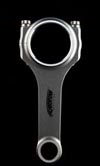Connecting Rods: Material Choices (4)
 Last month, we looked further into the use of titanium for con rods and this month we look briefly into the use of steel, which remains in many cases the material of choice for con rods. There are far more manufacturers of con rods who offer steel rods than any other material. Titanium is definitely on the increase, and possibly the time will come where steel becomes a ‘minority’ material choice. Some of the reason for steel remaining popular is the price of the raw material – it remains markedly cheaper than titanium. Another important reason is the familiarity of the suppliers with steel con rods. Many have a great deal of expertise with making steel con rods and have no wish to put their hard-earned reputation at risk whilst developing a reliable design for titanium con rods.
Last month, we looked further into the use of titanium for con rods and this month we look briefly into the use of steel, which remains in many cases the material of choice for con rods. There are far more manufacturers of con rods who offer steel rods than any other material. Titanium is definitely on the increase, and possibly the time will come where steel becomes a ‘minority’ material choice. Some of the reason for steel remaining popular is the price of the raw material – it remains markedly cheaper than titanium. Another important reason is the familiarity of the suppliers with steel con rods. Many have a great deal of expertise with making steel con rods and have no wish to put their hard-earned reputation at risk whilst developing a reliable design for titanium con rods.
So, is there a case for steel as a con rod material, other than on economic grounds or lack of familiarity with new materials? The answer is, in some cases, yes. We have previously looked at some of the drawbacks of titanium; it can be said that part of the continued attraction of steel is due to the disadvantages of titanium.
Certainly steel does not suffer from any of the surface related woes of titanium. Galling, the process whereby cold-welding of material causes seizure, does not affect steel, but can be a serious problem for titanium. Galling can affect threads and so the installation of con rod bolts can be very sensitive to this effect in titanium con rods. We know that the con rod bolt is one of the most highly-stressed components in a racing engine, and therefore one of the most critical. Failure of a con rod bolt often spells disaster in a racing engine, resulting in extensive (and expensive) damage. The other area in which titanium can suffer is the small end. Titanium con rods can suffer galling during insertion of the small end bush and this galling damage can act as a stress raiser. Steel does not suffer this problem and so there is no need to worry when inserting a bush, or when re-bushing con rods. Owing to the fact that the surface of titanium is liable to be damaged even under low levels of stress, titanium con rods have to be carefully looked after and handled. Steel con rods are not so sensitive in this regard.
There are some advantages to using steel, and these are not to be underestimated. The stiffness of steel is much higher than that of titanium and this can be of use when designing the con rod. It is also of direct use in mitigating the level of cyclic stress in the con rod fastener. As we have illustrated in the print issue of Race Engine Technology (RET 41, September/October 2009) the ratio of bolt stiffness to joint stiffness, along with the service loads, dictates the level of stress amplitude in the fastener. In this context, a higher stiffness for the joint components is advantageous.
The disadvantage of steel, in comparison to all of the other ‘main contenders’, is its density. With a density of 7.85 g/cc, it is almost 80% more dense than a typical titanium con rod alloy. This is a serious deficit in most circumstances. However, in an attempt to calm power delivery, some race engine developers have started to look seriously at steel because it offers a way to increase the inertia of the engine. People have been putting steel con rods into engines originally equipped with titanium rods purely for reasons of controlling power delivery.
Written by Wayne Ward.